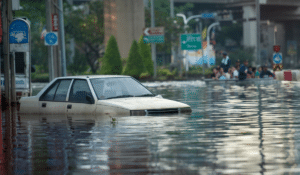The recent flash floods in New York highlight the critical importance of understanding and mitigating flood hazards in the workplace.
Underscoring the magnitude, as many as 23 million people were under flood watch across parts of New Jersey, New York and Connecticut as intense rain pounded the region.
By 9:45 a.m., Friday, September 29, most areas around New York City had already eclipsed 4 inches of rain, leading to severe flooding in the area. And, by the end of the rainfall event, some locations saw double that amount, with JFK Airport recording a record-setting 8.67 inches of rain.
Floods, whether caused by heavy rainfall, storm surges, or other natural disasters, can pose significant risks to workers across various industries.
Here, we’ll explore the hazards associated with floods, and delve into proactive measures you can take to ensure the safety and well-being of your workforce.
Let’s break it down.
Related Article: The Hidden Respiratory Dangers of Storms & Hurricanes
Flood Hazards in the Workplace
-
- Physical Dangers
Floodwaters can carry immense force, posing a threat of drowning or injury from debris. Fast-moving water can make it challenging to maintain balance, and even relatively shallow water levels can hide hazards beneath the surface.
- Contamination and Health Risks
Floodwaters often carry contaminants, including sewage, chemicals, and other hazardous materials. Exposure to these substances can lead to a range of health issues, from skin infections to respiratory problems.
- Electrical Hazards
Flooding can compromise electrical systems, increasing the risk of electric shock or fires. Submerged equipment or wiring can remain hazardous even after waters recede.
- Structural Damage
Buildings and infrastructure can be weakened or compromised by flooding, increasing the risk of collapses or other structural failures.
- Psychological Impact
Experiencing a flood or its aftermath can have a profound psychological impact on workers. Anxiety, stress, and trauma remain common responses, and addressing mental health concerns is crucial.
Combating Flood Hazards in the Workplace
- Develop a Comprehensive Emergency Response Plan
Develop and regularly review an emergency response plan that specifically addresses flood scenarios.
This plan should include evacuation procedures, designated assembly points, and methods for accounting for all personnel.
To this end, OSHA offers a wide variety of resources for addressing and mitigating flood hazards in the workplace, as well as official guidelines.
- See: OSHA’s Role in Emergency Response
- See OSHA Guidelines on Flood Preparedness and Response: Introduction
- See OSHA Guidelines on Flood Preparedness and Response: Preparedness
- See OSHA Guidelines on Flood Preparedness and Response: Response/Recovery
- Training and Drills
Conduct regular training sessions and drills to ensure all employees understand their roles and responsibilities in the event of a flood. This includes proper evacuation procedures, first aid, and the use of safety equipment.
Related Article: The Critical Importance of a Workplace Evacuation Plan
- Risk Assessment and Preparedness
Identify flood-prone areas within the workplace and implement preventive measures, such as barriers, sandbags, or elevated platforms to protect critical equipment and workspaces.
- See OSHA Factsheet on Keeping Workers Safe during Disaster Cleanup and Recovery
- See OSHA Factsheet on Filling, Moving and Placing Sandbags During Flooding Disasters
- Electrical Safety Measures
If your workplace is in a potential flood zone, consider elevating critical electrical systems or relocating them to higher ground to minimize the risk of electrical hazards.
Additionally, you’ll want to implement ground fault circuit interrupters (GFCIs) and conduct regular inspections of electrical equipment.
– See OSHA Factsheet on Working Safely Around Downed Electrical Wires
- Personal Protective Equipment (PPE)
Provide appropriate PPE, including waterproof boots, gloves, and eye protection, to safeguard workers during flood response and recovery efforts. Keep in mind that
– See OSHA Factsheet on Disaster Cleanup and Recovery PPE Matrix
– See OSHA Guidelines on PPE for Emergency Response and Recovery Workers
- Communication Protocols
Establish clear lines of communication to relay important information before, during, and after a flood. This includes utilizing emergency notification systems, radios, and other communication tools.
- Post-Flood Recovery and Support
After a flood event, offer support services to employees, including access to mental health resources and assistance with cleanup efforts.
- See OSHA Factsheet on Search and Rescue Operations
- See OSHA Factsheet on Fungi Hazards and Flood Cleanup
- See OSHA Factsheet on Flood Cleanup
- See OSHA Factsheet on Cleanup Hazards
Bringing It Together
The recent flash floods in New York serve as a stark reminder of the potential flood hazards in the workplace can pose to workers everywhere.
By understanding these risks and implementing proactive measures, you can create a safer work environment that protects both the physical and mental well-being of your workforce.
A comprehensive approach that includes emergency planning, training, risk assessment, and ongoing support is essential in mitigating the impact of floods on the workplace.
Remember, preparation today can make all the difference in safeguarding the future of your workforce.
About Worksite Medical
In most cases, OSHA requires medical surveillance testing, and at no cost to employees.
Worksite Medical makes that program easier with mobile medical testing.
We conduct on-site respirator fit tests, as well as audiometric exams, pulmonary function tests and heavy metal lab work, right on your job site. We also keep accurate, easy-to-access medical records for your convenience. You’ll keep your employees at work, and stay ahead of OSHA inspections.




